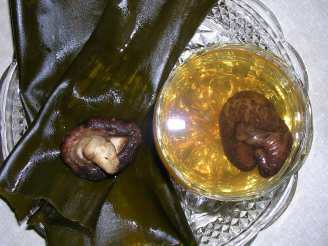Dashi (Japanese Stock)

- Ready In:
- 12mins
- Ingredients:
- 3
- Serves:
-
6
ingredients
- 6 cups cold water
- 1 piece giant dried kelp, about 10 x 3 inches (kombu)
- 3⁄4 cup dried bonito flakes (katsuo bushi)
directions
- Put the water into the pot.
- Dampen a cloth or paper towel, wring it out, and use it to gently pat the surface of the piece of kelp- do not wipe it hard, just remove surface dust; some of the white powder clinging to it is clean pleasant flavor from the ocean.
- Put the kelp into the pot.
- Heat the water, and when you can tell it is about to boil, but before it does, remove the kelp.
- Add the bonito flakes and let the water come to a full boil.
- As soon as the water starts to boil, turn off the heat.
- Let the bonito flakes start to settle to the bottom of the saucepan.
- You can strain the soup as soon as the flakes start to settle- 30 seconds to 1 minute, or, for a stronger flavor (which you may or may not want depending on what you are making) you can leave them in a few minutes longer- some of the recipes I have seem to imply that the flakes will all settle within a few minutes, but perhaps that depends on the kind you have; mine never all settle, and I find that a soak longer than a few minutes does not improve the flavor much anyway.
- To strain: line a strainer with a piece of cheesecloth (optional, but neater), and filter the dashi through it.
- You now have ichiban dashi.
- This dashi will keep for a few days in a glass container in the refrigerator.
- You can also make secondary dashi (niban dashi) by re-using the kelp and bonito flakes once; I haven't practiced that yet.
Questions & Replies
Got a question?
Share it with the community!
RECIPE SUBMITTED BY
I live in Los Angeles, and there are really great farmer's markets here, and corner stores featuring foods of many nations. I try to take advantage of these resources by using fresh seasonal produce and trying foods from different cultures. I don't exactly have the problem of not being able to find exotic ingredients; more often, I see things in the local stores (lotus root! passionfruit! chayote!) that turn out to be delicious when I finally learn how to prepare them. Interested in expanding my repertoire of techniques and cuisines, I finally took up my sister - Recipezaar member Roosie - on her recommendation to visit this site. I hear our parents use it too sometimes, but they don't seem to have figured out how to write reviews. My culinary pet peeve is when people stir rice while it's cooking, thereby making it gummy.

